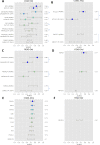Histopathology images predict multi-omics aberrations and prognoses in colorectal cancer patients
- PMID: 37055393
- PMCID: PMC10102208
- DOI: 10.1038/s41467-023-37179-4
Histopathology images predict multi-omics aberrations and prognoses in colorectal cancer patients
Abstract
Histopathologic assessment is indispensable for diagnosing colorectal cancer (CRC). However, manual evaluation of the diseased tissues under the microscope cannot reliably inform patient prognosis or genomic variations crucial for treatment selections. To address these challenges, we develop the Multi-omics Multi-cohort Assessment (MOMA) platform, an explainable machine learning approach, to systematically identify and interpret the relationship between patients' histologic patterns, multi-omics, and clinical profiles in three large patient cohorts (n = 1888). MOMA successfully predicts the overall survival, disease-free survival (log-rank test P-value<0.05), and copy number alterations of CRC patients. In addition, our approaches identify interpretable pathology patterns predictive of gene expression profiles, microsatellite instability status, and clinically actionable genetic alterations. We show that MOMA models are generalizable to multiple patient populations with different demographic compositions and pathology images collected from distinctive digitization methods. Our machine learning approaches provide clinically actionable predictions that could inform treatments for colorectal cancer patients.
© 2023. The Author(s).
Conflict of interest statement
K-H.Y. is an inventor of US 16/179,101, entitled “Quantitative Pathology Analysis and Diagnosis using Neural Networks.” This patent is assigned to Harvard University. K-H.Y. was a consultant of Curatio. DL. K.W. is currently a stakeholder and employee of Vertex Pharmaceuticals. This study was not funded by this entity. All other authors have nothing to disclose.
Figures







References
Publication types
MeSH terms
Grants and funding
LinkOut - more resources
Full Text Sources
Other Literature Sources
Medical

